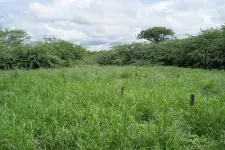(Press-News.org) PRESS RELEASE FROM THE UNIVERSITY OF CAMBRIDGE
EMBARGOED UNTIL 05:01 LONDON TIME (GMT) ON THURSDAY 13 JULY 2023
Images and paper available at: https://drive.google.com/drive/folders/18XRYP9dHcC1Z8lc3B86j3k6BzgIesqUS?usp=sharing
Small-winged and lighter coloured butterflies likely to be at greatest threat from climate change
The family, wing length and wing colour of tropical butterflies all influence their ability to withstand rising temperatures, say a team led by ecologists at the University of Cambridge. The researchers believe this could help identify species whose survival is under threat from climate change.
Butterflies with smaller or lighter coloured wings are likely to be ‘losers’ when it comes to climate change, with the Lycaenidae family, which contains over 6,000 species of butterflies, the majority of which live in the tropics, found to be particularly vulnerable.
Butterflies with larger or darker coloured wings are likely to fare better under increasing temperatures, but only to a point. Researchers say these butterflies could still experience dramatic declines if there were sudden heatwaves or if cool microclimates were lost through deforestation.
The results are published today in the Journal of Animal Ecology.
Butterflies rely on the sun’s warmth to give them the energy they need to function. They use ‘thermoregulation’ strategies to maintain a balanced body temperature against changing air temperatures.
Generally, strategies to keep cool involve adaptive behaviours like flying to a shady spot or angling wings away from the sun (thermal buffering). But when this is not possible or temperatures become too hot, species have to rely on physiological mechanisms such as the production of heat shock proteins to withstand high temperatures (thermal tolerance). Both of these strategies are needed to cope with climate change.
Researchers collaborated with the Smithsonian Tropical Research Institute (STRI) to study the thermal buffering and thermal tolerance strategies of tropical butterflies. They collected data from multiple habitats in Panama.
Equipped with hand-held nets, ecologists took the temperature of over 1,000 butterflies using a tiny thermometer-like probe. They compared each butterfly’s temperature to that of the surrounding air or the vegetation it was perched on. This gave a measurement of thermal buffering – the ability to maintain a steady body temperature against fluctuating air temperatures.
A second experiment was conducted at STRI Gamboa facilities and involved assessing butterflies’ thermal tolerance – their ability to withstand extreme temperatures, such as those they may experience during a heatwave. This was assessed by capturing a subset of butterflies and placing them in glass jars within a water bath – the temperature of which was steadily increased. Thermal tolerance was assessed as the temperature at which butterflies could no longer function.
Butterflies that had large wings tended to have greater thermal buffering ability but less thermal tolerance than smaller butterflies. Indeed, in a further study conducted by the same research team, butterflies with larger, longer and narrower wings were found to be better at thermal buffering.
Thermal buffering abilities were found to be stronger in darker-winged butterflies who could also tolerate higher temperatures than paler-winged butterflies.
Butterflies from the Lycaenidae family which have small, bright, and often iridescent, wings had the poorest thermal buffering and low thermal tolerance. If temperatures continue to rise at the current rate, forests continue to be cut down, and cool microclimates are lost, there is a very real threat that we could lose many species in this family in the future, say the researchers.
A trade-off in terms of butterflies’ cooling strategies was observed: those that were good at thermal buffering were less good at thermal tolerance and vice versa.
Scientists say this suggests that tropical butterflies have evolved to cope with temperature changes using one of these strategies at the expense of the other, and that this is likely to be due to selective pressures.
Lead author Esme Ashe-Jepson, a PhD student at Cambridge’s Department of Zoology, said: “Butterflies with physical characteristics that may help them to avoid the sun’s heat, like having large wings that enable them to fly quickly into shade, rarely experience high temperatures, and so have not evolved to cope with them. On the other hand, species which can cope with higher temperatures physiologically have experienced less selective pressure to evolve heat-avoiding behaviours.
“As temperatures continue to rise, and forest fragments get smaller and further apart because of deforestation, butterflies which rely on their surroundings to avoid high temperatures may not be able to travel between forest fragments, or cope with increasingly common heatwaves.”
The researchers say this means that species with large dark wings that are good at thermal buffering may initially be unaffected by warming temperatures, as they can continue to thermoregulate effectively using behaviour and microclimates, but their survival could be at risk if there are sudden heatwaves, or they can no longer escape to cool vegetation.
“Ultimately all insects, including butterflies, the world over are likely to be affected by climate change,” said Ashe-Jepson. “Adaptation to climate change is complex and can be impacted by other factors such as habitat destruction. We need to address these two global challenges together.”
Further research is needed to investigate the effect a warming climate may have on other life stages of butterflies, such as caterpillars and eggs, and other insect groups.
Senior author Greg Lamarre, at the Czech Academy of Science and Research Associate at STRI said: “Worldwide, most entomologists are observing drastic declines in insect biodiversity. Understanding the causes and consequences of insect decline has become an important goal in ecology, particularly in the tropics, where most of terrestrial diversity occurs.”
The research was funded by the GACR Czech Science Foundation, an ERC Starting Grant, a Smithsonian Tropical Research Institute short-term fellowship, and the Sistema Nacional de Investigación (SENACYT), Panama.
ENDS.
Reference:
Esme Ashe-Jepson et al. Tropical butterflies use thermal buffering and thermal tolerance as alternative strategies to cope with temperature increase. Journal of Animal Ecology DOI: 10.1111/1365-2656.13970
Contact details:
Charis Goodyear, University of Cambridge: Charis.Goodyear@admin.cam.ac.uk
Esme Ashe-Jepson, University of Cambridge: ea483@cam.ac.uk
About the University of Cambridge
The University of Cambridge is one of the world’s leading universities, with a rich history of radical thinking dating back to 1209. Its mission is to contribute to society through the pursuit of education, learning and research at the highest international levels of excellence.
Cambridge was second in the influential 2023 QS World University Rankings, the highest rated institution in the UK.
The University comprises 31 autonomous Colleges and over 100 departments, faculties and institutions. Its 20,000 students include around 9,000 international students from 147 countries. In 2022, 72.5% of its new undergraduate students were from state schools and more than 25% from economically disadvantaged backgrounds.
Cambridge research spans almost every discipline, from science, technology, engineering and medicine through to the arts, humanities and social sciences, with multi-disciplinary teams working to address major global challenges. In the Times Higher Education’s rankings based on the UK Research Excellence Framework, the University was rated as the highest scoring institution covering all the major disciplines.
The University sits at the heart of the ‘Cambridge cluster’, in which more than 5,200 knowledge-intensive firms employ more than 71,000 people and generate £19 billion in turnover. Cambridge has the highest number of patent applications per 100,000 residents in the UK.
www.cam.ac.uk
END
Small-winged and lighter colored butterflies likely to be at greatest threat from climate change
The family, wing length and wing color of tropical butterflies all influence their ability to withstand rising temperatures, say a team led by ecologists at the University of Cambridge. The researchers believe this could help identify species whose survi
2023-07-13
ELSE PRESS RELEASES FROM THIS DATE:
Unexpected coupling with leaky mode unveils new path for dense photonic integration
2023-07-13
Defying conventional wisdom, researchers have uncovered a novel coupling mechanism involving leaky mode, previously has been considered unsuitable for high-density integration in photonic circuits. This unexpected finding opens new possibilities for dense photonic integration, revolutionizing the scalability and application of photonic chips in optical computing, quantum communication, light detection and ranging (LiDAR), optical metrology, and biochemical sensing.
In a recent Light Science & Application publication, Sangsik Kim, associate professor of electrical engineering ...
Unemployment and underemployment significant drivers of suicide: Analysis
2023-07-13
A study examining unemployment and underemployment figures and suicide rates in Australia has found both were significant drivers of suicide mortality between 2004-2016.
The researchers say the findings indicate that economic policies such as a Job Guarantee, which prioritise full employment, should be a core part of any comprehensive national suicide prevention strategy.
Predictive modelling also revealed an estimated 9.5 percent of suicides reported during that time resulted directly from unemployment ...
Multisensory information detection by using multi-channel electrocorticography film that can place over a wide area of the cerebral cortex
2023-07-13
Overview
Associate Professor Hiroto Sekiguchi (Department of Electrical and Electronic Information Engineering, Toyohashi University of Technology) and Assistant Professor Susumu Setogawa and Associate Professor Noriaki Ohkawa (Comprehensive Research Facilities for Advanced Medical Science, Dokkyo Medical University; Assistant Professor Setogawa is currently a Specially Appointed Assistant Professor at University Public Corporation Osaka) have developed a flexible electrocorticography (Note 1) film for simultaneous detection of multisensory information (Note 2) from multiple regions of the cerebral cortex by placing neural ...
Fungi blaze a trail to fireproof cladding
2023-07-13
Mycelium, an incredible network of fungal strands that can thrive on organic waste and in darkness, could be a basis for sustainable fireproofing. RMIT researchers are chemically manipulating its composition to harness its fire-retardant properties.
Associate Professor Tien Huynh, an expert in biotechnology and mycology, said they’ve shown that mycelium can be grown from renewable organic waste.
“Fungi are usually found in a composite form mixed with residual feed material, but we found a way to grow pure mycelium sheets that can be layered and engineered into different uses – from flat panels for the building industry to a leather-like material for ...
Investigating interactions at molecular junctions for novel electronic devices
2023-07-13
The structure of a molecular junction with noncovalent interaction plays a key role in electron transport, reveals a recent study conducted by researchers at Tokyo Tech. Through simultaneous surface-enhanced Raman scattering and current–voltage measurements, they found that a single dimer junction of naphthalenethiol molecule shows three different bondings, namely π–π intermolecular and through-π and through-space molecule–electrode interactions.
The π–π interaction is a type of noncovalent interaction that occurs when the electron clouds in the π orbitals ...
Researchers report advance in immune therapy against ALS
2023-07-13
New research suggests that targeting autoimmune inflammation associated with amyotrophic lateral sclerosis (ALS) using two drugs, one of them already approved for multiple sclerosis, could be a promising approach for treatment.
ALS, also known as Lou Gehrig's disease, is a progressive neurodegenerative disease that affects the nerve cells in the brain and spinal cord. It leads to the gradual loss of muscle control, eventually resulting in paralysis and difficulty with speech, swallowing, and breathing. The exact cause of ALS is not fully understood, and currently, there is no cure ...
Taylor & Francis reduces plastic by introducing paperwrap for UK mailed journals
2023-07-13
Taylor & Francis has taken a significant step in reducing unnecessary plastic use with the introduction of paperwrap for journal print copies mailed in the UK.
Paperwrap, a relatively new packaging technology, has become more common in recent years, but is typically most suited to publications with very high print runs. Taylor & Francis’ Global Supplier Team spent several months investigating how it might be applied to journal print runs, which included rolling out live trial mailings to colleagues around the world to test how the journals could be packaged, and whether there was any impact on the speed ...
New talking therapy for depression could be more effective and cheaper than CBT
2023-07-13
A new talking therapy for depression has shown encouraging early signs of being more effective and cheaper to deliver than the current best practice of Cognitive Behavioural Therapy (CBT).
A pilot trial from the University of Exeter, funded by the National Institute of Health and Care Research (NIHR) and published in Lancet EClinical Medicine, has found Augmented Depression Therapy (ADepT) could be a significant advance in depression care.
A core feature of depression is anhedonia (reduced ...
Three ways to fight invasive Prosopis juliflora tree in Eastern Africa all proved very effective, new study shows
2023-07-13
A team of scientists led by CABI have conducted a new study which shows that three ways to fight the invasive Prosopis juliflora tree in Ethiopia, Kenya and Tanzania all proved very effective in almost all cases.
The three-year research, published in the journal CABI Agriculture and Bioscience, revealed that cut stump and basal bark herbicide application and manual uprooting were highly effective, killing the trees in between 85-100% of cases.
In addition, three incremental restoration interventions were tested ...
Poignant photo project reveals all we lost in lockdown
2023-07-13
Laptops and schoolwork on kitchen tables, a deserted playground, face masks on a washing line, an empty church, a walk in the woods.
As the UK Covid inquiry continues for a fifth week, researchers at the University of East Anglia have created a unique snapshot of lockdown life.
When the pandemic first hit, the team embarked on a project to track the physical and mental health of the nation. More than a thousand participants signed up and up and they were followed every day for three months in the first study of its kind.
As well as keeping daily lifestyle diaries about their physical activity, diet and mood, ...
LAST 30 PRESS RELEASES:
School meals could unlock major gains for human and planetary health
Menopause hormone therapy does not appear to impact dementia risk
Signature patterns of brain activity may help predict recovery from traumatic brain injury
Dresden study uncovers new key mechanism in cancer cells
New species are now being discovered faster than ever before, study suggests
Cannabis-based products show limited short-term benefit for chronic pain, with increased risk of adverse effects
Cannabis products with more THC slightly reduce pain but cause more side effects
Clearing the brain of aging cells could aid epilepsy and reduce seizures
Brain injuries linked with potential risk of suicide, new study finds
New technique lights up where drugs go in the body, cell by cell
New study finds movement of fishing fleets can reveal shifts in marine ecosystems
Embargoed: New evidence points to potential treatment for vascular dementia
Study uncovers disrupted brain balance in alcohol dependence
Working in groups can help Republicans and Democrats agree on controversial content moderation online
Structural findings reveal how distinct GPCR ligands create different levels of activation
Anything-goes “anyons” may be at the root of surprising quantum experiments
UC review: Maximizing workplace opportunity for veterans
From generation to complex control: Metasurfaces make perfect vortex beams "within reach"
Thin-film lithium niobate-based detector: recent advances and perspectives
Exploring why some people may tend to persistently make bad choices
How cells balance their protein levels
Nirsevimab vs RSVpreF vaccine for RSV–related hospitalization in newborns
Effectiveness and impact of maternal RSV immunization and nirsevimab on medically attended RSV in US children
AI gives scientists a boost, but at the cost of too many mediocre papers
Next-generation vision model maps tree growth at sub-meter precision
Genes aren’t destiny for inherited blindness, study shows
MIT study: High-fat diets make liver cells more likely to become cancerous
Exposure to multiple fine particulate matter components and incident depression in the US Medicare population
Risk of burdensome health care spending over time in the US
Nirsevimab against hospitalizations and emergency department visits for lower respiratory tract infection in infants
[Press-News.org] Small-winged and lighter colored butterflies likely to be at greatest threat from climate changeThe family, wing length and wing color of tropical butterflies all influence their ability to withstand rising temperatures, say a team led by ecologists at the University of Cambridge. The researchers believe this could help identify species whose survi








